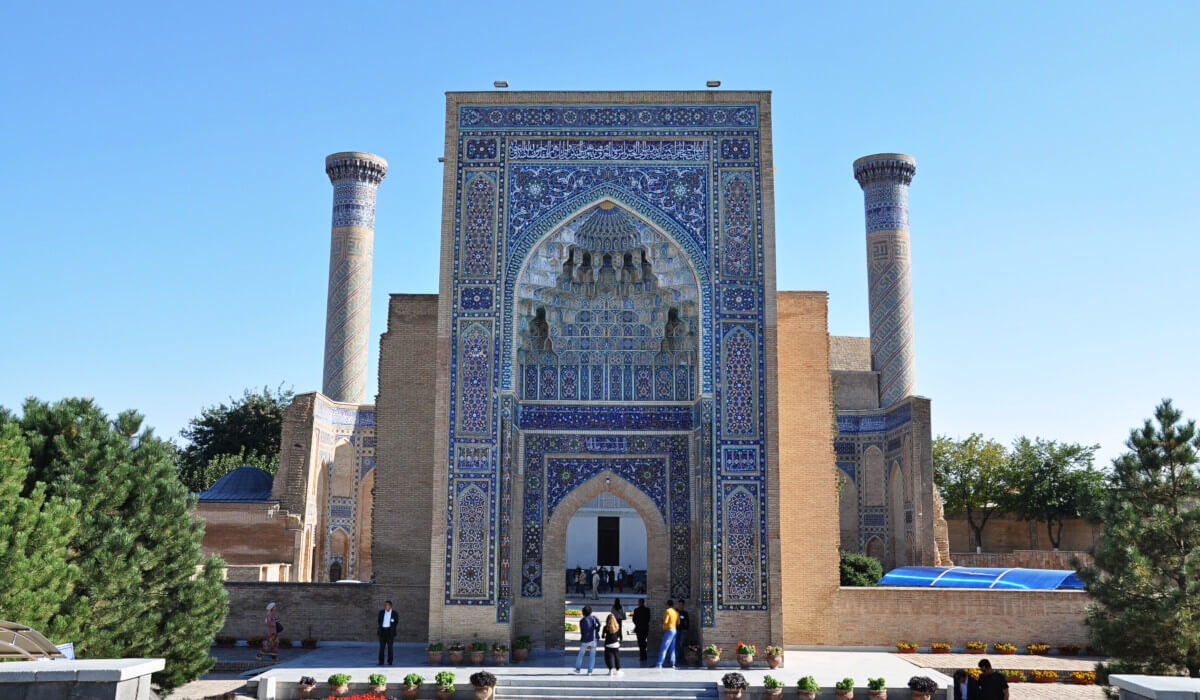Pre-history of the Gur-Emir Mausoleum
Tamerlane (known as Amir Timur in Uzbekistan) was a great military leader of Central Asia in the 14th-15th centuries. During his lifetime, he conquered a large number of countries and established the Timurid Empire with its capital city Samarkand. Towards the end of his life, Amir Timur decided that his grandson Muhammad Sultan would be heir to the throne after his death. The latter was considered a very educated man and was a brave warrior. After Muhammad Sultan was announced to be a Timur’s successor, he ordered the construction of a madrasah and a khanaka (a hostel for dervishes) in Samarkand. The children and grandchildren of the royal families got their education in the madrasah; therefore, theology and the Sharia were only part of their education. Children from royal families were prepared here to be future rulers. The madrasah was active until the 17th century. The khanaka stopped being used as traditional accommodation early on; it mainly housed respected clergy, wealthy merchants and state guests. None of these buildings had survived the passage of time; today, only the foundation walls remain.

Muhammad Sultan was assassinated in 1403 during a campaign in Asia Minor (present-day Turkey). His body was brought to Samarkand, and Amir Timur ordered the construction of a mausoleum for his beloved grandson. Timur decided to bury him in the place already associated with his grandson’s name through the madrasah and the khanaka.
Construction of the Gur-Emir Mausoleum
The construction of the mausoleum began in 1403 and already a year later the building was almost finished, only the cladding of the building was missing. Timur undertook a campaign to China; it happened to be his last. Despite his age, he began his campaign in winter. In persistent frost, he caught a cold and subsequently died from pneumonia in the Otrat city (present-day Turkestan in Kazakhstan). His body was brought to Samarkand and the family decided to bury him next to his grandson Muhammad Sultan in the Gur-Emir Mausoleum.
After Timur’s death, his fourth son Shahrukh took over his father’s empire and appointed his son Ulugbek to be governor of Transoxania. Under Ulugbek’s leadership, the entrance portal of the mausoleum was completed.
The tombs in the Gur-Emir Mausoleum
The Gur-Emir is a family mausoleum. There are nine graves in total: Timur himself, two of his sons (Shahrukh and Miranshah), two of his grandsons (Ulugbek and Muhammad Sultan) and two of his great-grandchildren (the sons of Ulugbek) are buried here. In addition, Timur’s spiritual mentor Mir Said Baraka also found his final resting place in the mausoleum. In a niche, there is also the tomb of a clergyman.
Despite all these important people of the Timurid dynasty, the mausoleum is known as Timur’s mausoleum.

the Gur-Emir Mausoleum: the legend of tombs opening
On 22 June (19 June) 1941, a group of archaeologists and scientists led by the anthropologist Gerasimov and the Uzbek scientist Karaniyazov went down into the basement of the mausoleum and opened the tombs of the crypt. The first thing they confirmed was that for almost 500 years, no one had opened those tombs, although robbers could be tempted by the treasures that might have been hidden there. The second fact that surprised them was that Timur’s body was lying in a coffin: Muslims are buried without a coffin, wrapping the body only in a shroud.
An autopsy revealed that Tamerlane was 172cm in height. The historical chronicles have always described him as a very tall man. For the 14th century, Timur’s height was above average.
Further investigations showed that he had an injury to his right knee and the elbow of his right arm. It confirmed that Timur was lame and explained why in historical chronicles he was called Timur-i-Leng (Lame Timur). In addition, the index finger of his right hand was injured, and a big scar was on his forehead. All this indicated that he was a brave warrior.
When Ulugbek’s grave was opened, it was immediately confirmed that he had been decapitated; his skull was placed next to his skeleton.
The remains of Timur and Ulugbek were taken to Moscow for further investigation. Anthropologist Gerasimov made a facial reconstruction of Timur and Ulugbek using recreating the individual’s face from its skeletal remains (forensic facial reconstruction).
The great patriotic war*
The Great Patriotic War is a term used in Russia and other former republics of the Soviet Union to describe the conflict fought from 22 June 1941 to 9 May 1945, primarily between the Soviet Union and Nazi Germany.
Local citizens were against the uncovering of the graves; elders were telling that negative things might happen. The day after the graves opened, Nazi Germany invaded the Soviet Union. Local people linked it to a curse about the graves opening. The indigenes told that the bodies must be returned to the mausoleum; otherwise, Timur’s spirit would not rest.

In December 1942 the remains were returned to Samarkand. The day after, Soviet troops won the first battle in Stalingrad (present Volgograd), taking a decisive turn in the war. The people of Samarkand again linked the victory with the return of the remains to their homeland.
A reburial commission was assembled in Samarkand. It was decided to bury Timur following Muslim tradition, at the bottom of the grave without the coffin. The coffin was given to the State Museum of History and Culture of Samarkand.